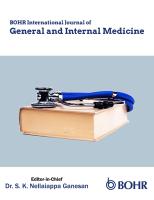Article,
The Impact of Age on Activity Index and Patient Reported Outcomes in Patients with Sjogren’s Syndrome
BOHR International Journal of General and Internal Medicine (BIJGIM), 1 (1): 11–14 (August 2022)
DOI: 10.54646/bijgim.003
Abstract
Sicca symptoms, such as xerostomia and xerophthalmia are prevalent in geriatric patients and are correlated to exhaustion and low quality of life. Sjögren's syndrome (SS), an autoimmune disorder characterized by lymphocytic infiltration of the exocrine glands, also exhibits xerostomia and xerophthalmia as a main feature. In clinical practice, tools exist to assess disease activity and severity of the symptoms of Sjögren's: the EULAR Sjögren's Syndrome Disease Activity Index (ESSDAI) and the EULAR Sjögren's Syndrome Patient Reported Index (ESSPRI) respectively. This study's objective is to assess the disease activity and complaints in a cohort of sicca syndrome patients, with an emphasis on senior individuals in particular. A cross-sectional investigation of 45 adult patients with a clinical diagnosis of sicca syndrome was conducted, comparing geriatric (> 65 years old; n=23) versus non-geriatric (n=22) subgroups with respect to demographic and clinical data, classification criteria fulfillment, disease activity and symptom burden. Between the two age groups, no statistically significant differences were found regarding disease duration, immunological and histological features, or disease activity, with overall low ESSDAI values. Symptom burden was relevant, expressed by high ESSPRI values. Drugs that could worsen sicca symptoms were frequently prescribed, mainly antidepressants. Symptom burden is significant in our cohort of SS patients. Unexpectedly, ESSPRI values were similar in both groups, despite the higher expected prevalence of sicca complaints in a geriatric population. Even in people with a mild illness, management of symptoms may be challenging and special attention is needed in geriatric population.
